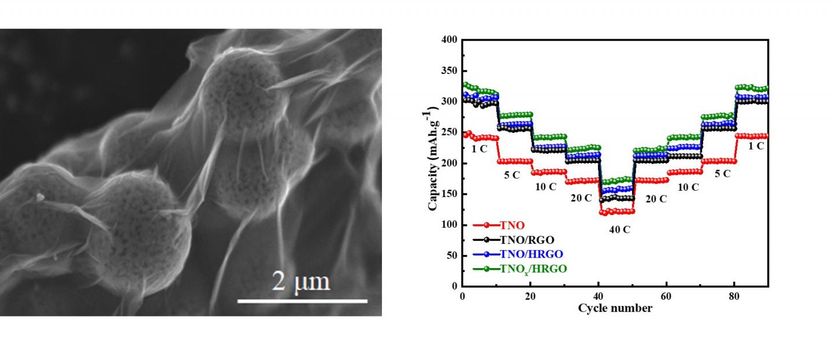Superior TNOx/HRGO hybrid anode for lithium-ion batteries
Researchers have significantly enhanced the performance of titanium niobium oxides for lithium-ion batteries
Advertisement
In a paper published in NANO, a team of researchers from Chengdu Development Center of Science and Technology have significantly enhanced the performance of titanium niobium oxides for lithium-ion batteries. This has applications in electric vehicles and mobile electronics.

The morphology image and rate capability of TNOx/HRGO, it can be seen that its structure is TNOx microspheres wrapped by gossamer-like HRGO, and its capacity is as high as 225 mAh/g and 173 mAh/g at 20 C and 40 C, respectively.
Due to its high security and capacity, titanium niobium oxide (TNO) has gained much attention as anode material for lithium-ion batteries. Yet, its electronic conductivity is too low to have high capability at high rates. In order to improve the high-rate performance of TNO effectively, a team of researchers from Chengdu Development Center of Science and Technology, China Academy of Engineering Physics, has combined utilized crystal structure modification, particle size reduction, porous structure, and conductive-phase compositing to solve this problem. The electrochemical performance, especially high-rate performance, of the material was significantly enhanced.
Ti2Nb10O29-x/HRGO hybrid was successfully fabricated by introducing vacancies into Ti2Nb10O29 (TNO) and hybridizing TNO with holey reduced graphene oxide. The structure of TNOx/HRGO is TNOx microspheres with oxygen vacancies wrapped by gossamer-like HRGO. Electrochemical measurements confirmed that TNOx/HRGO hybrid exhibited excellent reversible capacity of 316 mAh/g, 278 mAh/g, 242 mAh/g, 225 mAh/g, and 173 mAh/g at 1 C, 5 C, 10 C, 20 C, and 40 C, respectively. After 300 cycles at 10 C, it still has a high capacity of 238 mAh/g with a high capacity retention of 98%, revealing excellent cycling stability.
The oxygen vacancies of TNOx and the high conductivity of HRGO can effectively enhance the electronic conductivity of the TNOx/HRGO hybrid, and the HRGO holes are beneficial for the transmission of lithium-ion (Li+). The synergy effect of above features improves the rate performance of the TNOx/HRGO hybrid. In addition, the existence of HRGO can buffer volume expansion during the insertion processes of Li+, which can improve cyclic stability of the TNOx/HRGO hybrid.
In this paper, combined utilization of several methods is proved to be an effective way to improve the electrochemical performance of TNO. Ti2Nb10O29-x/HRGO hybrid can be a potential anode material for lithium-ion storage with high security and high capacity, as well as excellent high-rate and cycle performance.
Original publication
Other news from the department science
These products might interest you
Most read news
More news from our other portals
See the theme worlds for related content
Topic World Battery Technology
The topic world Battery Technology combines relevant knowledge in a unique way. Here you will find everything about suppliers and their products, webinars, white papers, catalogs and brochures.

Topic World Battery Technology
The topic world Battery Technology combines relevant knowledge in a unique way. Here you will find everything about suppliers and their products, webinars, white papers, catalogs and brochures.
































































